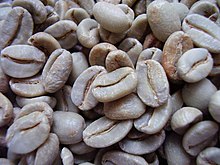Coffee roastery
A coffee roastery is an operational facility for the production of roasted coffee from raw coffee . In it, green coffee beans are processed for the end consumer .
Procedure

Green coffee is delivered in silo vehicles, in bags or in containers and then weighed. While loose coffee can be conveyed directly into a silo for temporary storage, the bagged goods must first be opened and emptied automatically. Before intermediate storage, the green coffee is removed from foreign substances, such as B. sack fibers, stones or wood, exempt. The transport to the silos is carried out by bucket elevators for short distances and pneumatically for longer distances . The raw coffee is transported to the coffee roaster mechanically, pneumatically or in free fall .
During the roasting process, which takes place at temperatures of 100 ° C to 260 ° C by means of convection or contact, the water contained in the green coffee is evaporated and the coffee beans expand to around twice their original volume. The skins adhering to the coffee beans flake off during this process. Continuous circulation of the beans ensures that they are heated evenly. The roasting process is interrupted by rapid cooling. This is done either by adding cooling air or spraying water. There are both continuous and discontinuous roasters. The roasting times are between one and a half and twenty minutes.
After the roasting process, the coffee beans are removed from any contaminants that may still be present, e.g. B. stones or metal parts, exempt. This is usually done using an air classifier . The beans are then packaged either ground or unground. The beans are again transported to the mill or to the packaging device pneumatically or mechanically. It is important for the quality of the roasted coffee that contact with oxygen is avoided after the roasting process in order to prevent the coffee from aging. At the same time, the beans must be given the opportunity to outgas.
Emissions
Dust emissions are to be expected in particular during the transport and pneumatic separation processes. Due to the partial expulsion and the subsequent oxidation of the expelled caffeine during the roasting process, coffee roasters often have high nitrogen oxide emissions . In addition, gaseous organic compounds, such as. B. acetic acid , emitted.
Roasting plants in DACH
Germany

Xavier Plum began roasting coffee for his customers in Aachen as early as 1820. The company still exists today. Johann Jacobs opened a special shop for coffee, tea, cocoa, chocolate and biscuits in Bremen in 1895 and began roasting coffee in 1907. During the Second World War, production was destroyed and rebuilt; due to a lack of raw materials, a lot of substitute coffee was roasted until the post-war period . Other large roasting plants in Germany are Tchibo (with Eduscho ), Dallmayr , Melitta , Darboven (with the own brands Eilles, Idea and Mövenpick) and Aldi .
In addition to the large industrial roasting plants, there are a large number of small roasting plants.
Austria
There are currently around 100 roasting companies in Austria. The trading organization Spar , which was founded in Tyrol in 1954, began roasting coffee in the Linz duty-free zone in 1958 . The roastery moved to Marchtrenk on the B1 in 1991 and is now Austria's largest roasting plant with an annual output of 4000 tons. The own brand Regio coffee is still around today. There are currently (2018) 28 varieties roasted.
The coffee roasting company Cult Caffè started in Neumarkt an der Ybbs (Melk district) in 2003 and in 2018 supplied 60 tons of roasted coffee, mainly to the catering and hotel industry.
See also
literature
- VDI 3892 : 2015-03 Emission reduction - Roasted coffee producing industry - Plants with a daily production of at least 0.5 tonnes of roasted coffee (Emission control - Roasted-coffee-producing industry - Plants with a minimum daily output of at least 0.5 tonnes) . Beuth Verlag, Berlin ( summary online )
- H. Garloff, H. Lange, R. Viani: Coffee. In: Rudolf Heiss (ed.): Food technology . 3. Edition. Springer-Verlag, Berlin, Heidelberg, 1990, ISBN 3-540-51737-5 , pp. 358-370.
Web links
- "Coffee roasters" map of Germany from ZEITmagazin, February 23, 2016
Individual evidence
- ↑ https://www.plumskaffee.de/de/
- ↑ Jana Gioia Baurmann: Jacobs: Germany's most popular coffee comes from Neukölln tagesspiegel.de, October 24, 2011, accessed February 23, 2019.
- ↑ History: How it all began ... Jacobs Douwe Egberts AT GmbH, jacobskaffee.at, 2019, accessed February 23, 2019.
- ↑ The coffee is ready, meal! Magazin 2/2018, spar.at, March 15, 2018, accessed February 23, 2019.

